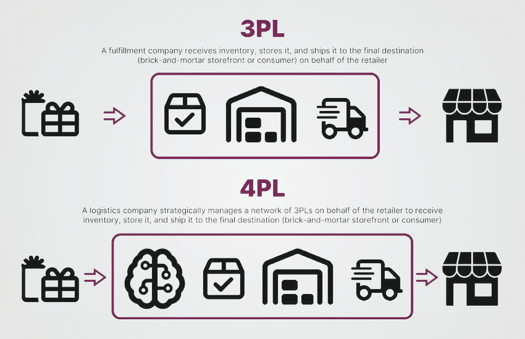With decades of experience catering to third-party logistics (3PL) providers, we know that these businesses have historically been a driving force in the logistics services industry, especially the warehousing sector. However, it’s becoming increasingly more common to see companies providing fourth-party logistics (4PL) or even fifth-party logistics (5PL) services.
With the rise of ecommerce, heightened consumer expectations (fueled by the Amazon Effect) now require service providers to become more agile to rise above the competition as logistics partners. Single-point distribution models increasingly struggle to keep up with the modern pace of ecommerce fulfillment and are less suited for complex supply chain operations. Now is the dawn of the 4PL era.
Through assembling a multi-nodal network of other geographically dispersed warehouses to provide consistently expedient last-mile delivery on behalf of their customers, these 3PLs are evolving into fourth-party logistics providers to create the future of fulfillment by embracing cutting-edge supply chain solutions.
In this article, we’ll dive into what makes up a 4PL and what’s driving the growing popularity of this logistics model.
What is a 4PL?
A fourth-party logistics provider (4PL) is a company that provides businesses with an outsourced end-to-end supply chain management network and infrastructure. 4PLs typically manage multiple fulfillment warehouses and enable companies to outsource the full scope of their logistics processes.
In addition to delivering traditional 3PL services at their main warehouse location or node, 4PLs also handle the project management of the entire network’s supply chain strategy. Think of them as the control tower for logistics solutions, taking care of everything you need for inventory management, order fulfillment, reverse logistics, and even sourcing & procurement.
There are two main forms 4PLs can take:
- Multiple distinct 3PL warehouses partnering together to create a 4PL network
- Standalone 4PL providers that independently oversee all the warehouse nodes in the supply chain network
What is the difference between 3PL and 4PL?
The main difference between 3PL and 4PL is that 4PL has an extra degree of distance between the logistics provider and consumer where the 3PL acts as an intermediary between the merchant and the final consumer, hence the “third-party” name.
Another key difference between 3PLs and 4PLs is that 3PL providers own all or most of their own assets necessary to provide logistics services in-house including warehouse space and sometimes even trucking fleets for freight forwarding.
By contrast, 4PLs can be non-asset-based; they provide logistics expertise and IT systems—fulfillment software—but may not own any warehouses or other physical assets. Instead, the 4PL provider acts as an outsourced partner that oversees the movement of goods, information, and services across the supply chain, utilizing advanced technologies and data-driven insights to optimize operations and improve overall supply chain performance.

A traditional third-party logistics provider owns the relationship with their client, say, a retailer or ecommerce business, and neither owns the products nor interacts with the purchasers of the brand’s products. However, let’s say this retail brand provides ecommerce customer service all over the country. If the 3PL only operates one or two warehouses, it can be difficult to provide the speed of shipping that the brand’s customers expect and remain cost-effective.
In this case, the 3PL provider may enlist other 3PL warehouses to assist with servicing regions in which it does not have warehouses. The organizer of this network of 3PLs is considered a 4PL and remains the single point of contact to their client.
The original 3PL can benefit from outsourcing portions of the logistics management process to others in different locations, allowing them to efficiently keep up with growing region and time expectations. It is a mutually beneficial process in which all 3PLs involved can take on more clients than they would be able to otherwise given capacity constraints and the difficult warehouse real estate market.
4 Biggest Advantages of 4PLs
The rise of 4PL can be attributed to supply chains' increasing complexity and globalization. Today's supply chains are vast networks spanning multiple countries and involving numerous suppliers, manufacturers, distributors, retailers, and customers. Managing such complex supply chains requires high levels of coordination, visibility, and efficiency, which can be challenging for businesses to achieve independently.
This is where 4PL comes into play, offering a holistic and strategic approach to supply chain management with core competencies grounded in technological sophistication and risk mitigation against supply chain disruptions & economic fluctuations.
Let’s look at some of the biggest advantages of the 4PL logistics strategy that strengthens the entire supply chain:
1. Advanced Technology
Beyond the standard warehouse management system (WMS) software, 4PL providers utilize advanced analytics, automation, artificial intelligence (AI), and other cutting-edge technologies to gain real-time visibility into the supply chain, track & analyze data, identify bottlenecks, and make data-driven decisions. This enables businesses to streamline their supply chain processes, reduce costs, improve delivery times, and enhance customer satisfaction. This also benefits their clientele by giving them access to advanced technologies—which can fuel business strategies like demand forecasting and improve supply chain visibility—that would be resource-intensive to acquire independently.

2. Expanded Reach
Traditional 3PL warehouses evolving to provide 4PL services can distribute inventory strategically by location, thereby cutting delivery times and costs. This organic 4PL network allows logistics companies to provide greater value for their clientele, such as the ability to deliver products across many geographic regions in ideal timeframes, while capitalizing on market opportunities to increase their potential revenue and profitability. This optimization of the logistics process enables the brands served to compete at scale in the world of ecommerce, which can boost customer retention and acquisition.
3. Strategic Partnerships
4PL companies often have access to a vast network of partners, suppliers, and carriers, which allows them to negotiate favorable rates and terms and optimize transportation routes, resulting in cost savings and improved efficiency. This means their clients wouldn’t need to manage multiple partners as the 4PL provider serves as the single point of contact for all of their logistics operations and fulfillment needs, enabling them to spend less time and energy orchestrating logistics processes and instead focus on other revenue-boosting business activities.

4. Flexibility & Scalability
Businesses can engage 4PL providers on a contract basis, allowing them to scale their supply chain operations up or down depending on their needs. This eliminates the need for businesses to invest in expensive infrastructure and resources to manage their supply chains, making it a cost-effective solution. Additionally, 4PL providers can offer customized solutions tailored to the unique requirements of each business, providing a high degree of flexibility and adaptability.
The Future of 4PLs
Looking into the future, 4PL is expected to continue its growth and evolution as businesses seek innovative ways to optimize their supply chains. The future of fourth-party logistics looks promising as businesses seek innovative ways to optimize their supply chains and overcome the challenges of an increasingly complex and globalized business environment.
With the increasing adoption of emerging technologies such as blockchain, Internet of Things (IoT), and machine learning, 4PL companies will have access to even more data and insights, enabling them to provide even better visibility, traceability, and efficiency across the supply chain. Moreover, as environmental concerns become more prominent, 4PL providers will likely focus on developing eco-friendly supply chain solutions.
Below are some other potential trends that could shape the future of 4PL:
AI and Automation
Warehouse technology trends like artificial intelligence and automation will likely play a significant role in the future of 4PL. AI-powered analytics can process vast amounts of data to generate insights, predictions, and recommendations, enabling 4PL providers to identify and address supply chain issues proactively. Automation, such as robotic process automation (RPA), can streamline repetitive tasks, reducing human error and increasing efficiency in supply chain processes.
Sustainable Solutions
With growing awareness and emphasis on sustainability and environmental concerns, 4PL providers will likely focus on developing eco-friendly supply chain solutions. This may include strategies to reduce carbon emissions, optimize transportation routes to minimize environmental impact, and implement circular economy principles, such as recycling and waste reduction.
Enhanced Collaboration
In the future, we can expect increased collaboration and integration among suppliers, manufacturers, distributors, retailers, and customers to optimize supply chain operations. This may involve collaborative platforms, shared data, and information exchange, enabling seamless coordination and visibility across the supply chain. 4PL providers will play a pivotal role in facilitating and orchestrating such collaborative efforts, acting as a central hub that connects and integrates all stakeholders in the supply chain ecosystem.
Customizability
As supply chains become more complex and dynamic, 4PL providers may offer tailored solutions that are flexible, scalable, and adaptable to changing business conditions. Predictive analytics, scenario planning, and risk management strategies will be used to proactively identify and address supply chain disruptions, optimize inventory levels, and improve overall supply chain resilience.
Customer Experience Focus
Customer experience is a critical factor in today's competitive business landscape, and it is expected to remain a key focus for 4PL providers. 4PL providers may prioritize customer-centric solutions that enhance customer satisfaction through improved delivery times, order visibility, and responsiveness to changing consumer demands. This will utilize customer analytics, demand sensing, and personalized services to provide an exceptional consumer experience throughout the supply chain journey.
Evolve into a 4PL with Extensiv
Emerging technologies necessary to bring fourth-party logistics to life are more attainable than ever before.
Extensiv's fulfillment solutions combine elements from our order management tool and 3PL WMS platform to give real-time visibility into inventory status, order fulfillment progress, and data analytics metrics across the 4PL network, allowing you to optimize inventory management and route orders from one 3PL to another.
Outsourcing a portion of the logistics process doesn’t have to mean giving up control or losing business to a competitor. In fact, the opposite is true; by creating your own 4PL network powered by Extensiv Network Manager—which boasts automation features that streamline, simplify, and illuminate billing processes at every node—all parties involved in the partnership profit from working together.
Request a demo to find out more about how Extensiv can help you embrace the future of logistics!
-
You’ll read about:
Be the first to know
Subscribe to our newsletter







